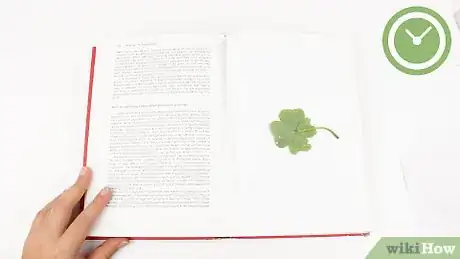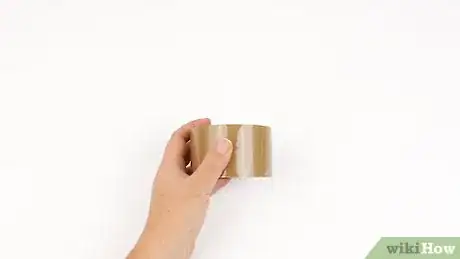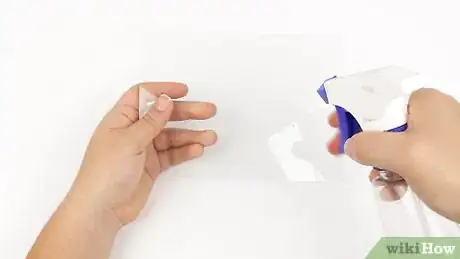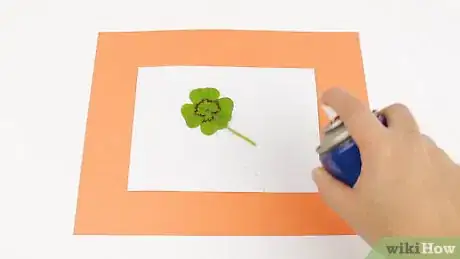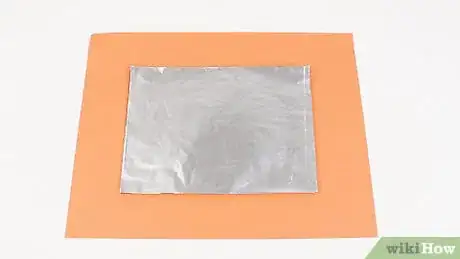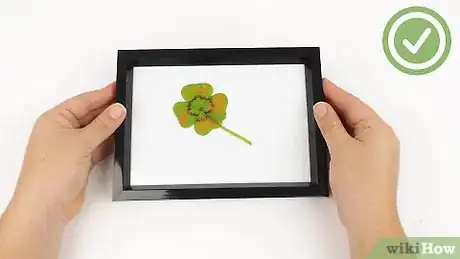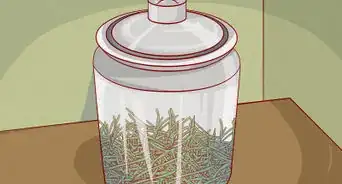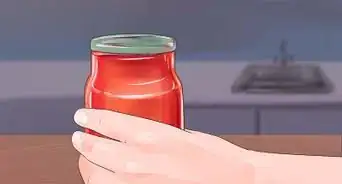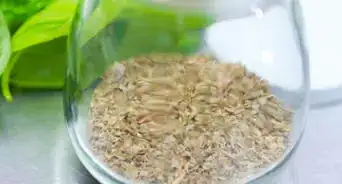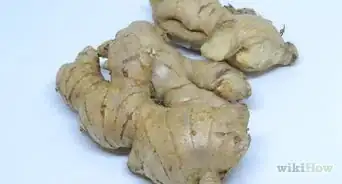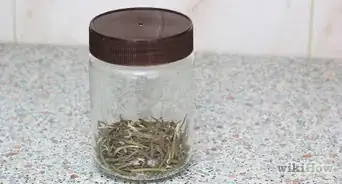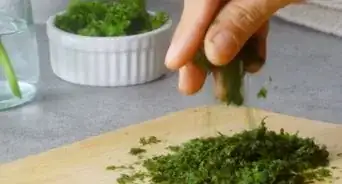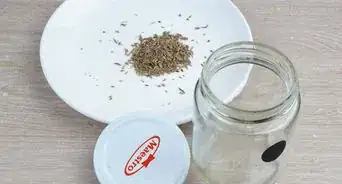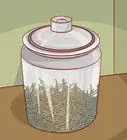This article was co-authored by wikiHow Staff. Our trained team of editors and researchers validate articles for accuracy and comprehensiveness. wikiHow's Content Management Team carefully monitors the work from our editorial staff to ensure that each article is backed by trusted research and meets our high quality standards.
There are 13 references cited in this article, which can be found at the bottom of the page.
The wikiHow Video Team also followed the article's instructions and verified that they work.
This article has been viewed 106,963 times.
Learn more...
Four leaf clovers are a sign of good luck for some, but won’t last very long if they’re left sitting out in the open. If you want to hold onto a four leaf clover to keep yourself lucky, you’ll need to press it to remove the moisture before preserving it. First, make sure you dry the clover in the pages of a heavy book. Then, preserve it by taping, laminating, or framing it to keep your four leaf clover nearby for years to come!
Steps
Pressing the Clover
-
1Find an old heavy book with non-laminated pages. Pressing a clover to preserve it involves flattening it and removing as much moisture as possible. An old book, such as an old dictionary or phonebook, will be heavy enough and absorbent enough to do this perfectly. Choose an old book you don’t mind damaging to press your clover in.[1]
- If you don’t want to damage a book, you can press the clover between a few pieces of paper inside the pages of the book. The moisture in the clovers will be absorbed by the paper.
- If you have one, you could also use a flower press to press your clovers.
-
2Position your four leaf clover near the middle of the book. Open the book to a page near the middle and place your clover inside. Put the leaves of the clover face down on the page and fold the stem towards the opening edge of the book. This will allow it to flatten properly.[2]
- Take a note of which page you placed your four leaf clover on. If it’s flattened enough, it might be difficult to find it in the book later on!
Advertisement -
3Close the book and wrap it with 4 or 5 rubber bands. Fold the front cover of the book back over, being careful to seal your clover or clovers flat in between the pages. Stretch some strong and tight rubber bands around the book to hold it closed. This will apply constant pressure to the clovers, drying and pressing them.[3]
- You could also apply pressure by stacking several other heavy books or objects on top of the pressing book, rather than wrapping it with rubber bands.[4]
-
4Leave the clover to dry for around 1 week. The amount of time it takes for a clover to dry completely will vary based on a number of different factors. After around a week, open the book up and check the clover. If it's green, dry, and completely flat, you've successfully pressed the clover! If it's still damp or isn't flat, return it to the book for another day.[5]
- If the clover is still damp after 2 weeks, the area you’re in may be too humid. Try moving the book to a dryer place to help the clover dry fully.
Preserving Your Clover with Tape
-
1Purchase an ultra-clear packing tape. In order to ensure you can see your pressed clover clearly while it’s preserved, choose the clearest or most glass-like packing tape that you can find. The tape should be at least the width of the clover to make sure it can be covered fully.[6]
- Scotch Ultra-Clear packing tape is a great option for preserving your clover, but any ultra-clear and wide tape will work.
-
2Lay 1 piece of tape on a flat surface. Peel a length of tape around 2 inches (5.1 cm) longer than your clover from the roll and cut it to length. Being careful to touch only the edges of the tape, lay it down on a flat surface with the sticky side facing upwards.[7]
- Any parts of the tape that you touch will stick to the natural oils on your fingers and leave a mark. Use the very tips of your fingers only on the edge of the tape to position it.
-
3Place your pressed clover in the middle of the tape. Press your index finger down onto the middle of the clover’s leaves and raise it to lift the clover up. Quickly and smoothly transfer it to the tape, pressing it down as close to the middle of the tape as you can get it.
- Lifting the clover by pressing your index finger into it is an easy way to pick it up from the center while keeping it flat. You could also lift it with a pair of tweezers or a similar tool for a little more accuracy.[8]
- Once you press the clover onto the surface of the tape, you won’t be able to move it again. Take care to position the clover properly before placing it on the tape.
-
4Cover the clover with another piece of tape. Cut a second piece of tape around the same size as the first. Line it up so that it covers the clover completely. Carefully lower one corner of the tape onto the first piece of tape. Stick the 2 pieces of tape together slowly, keeping them uniform to avoid any bubbles or creases.[9]
- It might help to use a ruler to evenly press the second piece of tape onto the first. This will help ensure that the tape goes on evenly and without any bumps.
-
5Trim away any excess tape. Use a pair of scissors to cut out a square around the preserved clover, making sure to leave enough space between the clover and the edges to keep the tape sealed together. Throw away the excess tape and keep your preserved four leaf clover somewhere safe.[10]
- You can cut the tape holding your clover to be any shape that you want, as long as the tape remains sealed. Try cutting it into a circle, a star, or even the shape of a four leaf clover!
Laminating Your Clover
-
1Lay your pressed clover inside a laminating sheet. Laminating sheets are a great and very easy way to preserve multiple clovers at once. Open the sheet so that the fold is facing towards the laminator and lay your pressed clover or clovers inside. Fold the sheet back over so that it is sitting flat with the clovers inside.[11]
- If you want to preserve multiple clovers, consider spacing them out so that you can cut them out individually once they’re laminated. This will give you a bunch of individual clovers, rather than a sheet of preserved clovers.
-
2Run the laminating sheet through a laminator. Turn on your laminator and allow it to warm up. Holding the laminating sheet as flat as possible, feed the sealed end of the laminating sheet into the laminator. Support the sheet as it pulls the sheet through and comes out the other side.[12]
- Avoid leaving your laminator turned on an unattended, as it can get very hot.
- Try placing your laminating sheet on a book the same height as the slot on the laminator. This will keep the sheet flat and prevent the clovers from moving around as they’re fed in.
-
3Cut away the excess laminate. Use a pair of scissors or a craft knife to cut out the preserved four leaf clovers, making sure to leave a sealed rim around each clover that you cut out. Throw away the excess laminate and keep your clover somewhere safe.[13]
Framing Your Clover
-
1Clean the glass of your chosen frame. Once your clover has been framed, you won’t be able to clean the glass any further. Take apart your picture frame and clean the glass with hot, soapy water. Once it’s clean, touch only the edges of the glass and leave it to dry fully for a few hours or overnight.[14]
- If you touch the surface of the glass with your fingers, the natural oils will leave visible fingerprints on the glass. Avoid touching the surface of the glass as much as you can once it’s been cleaned.
-
2Cut a piece of acid-free paper to the size of the frame. Acid-free paper will provide a backdrop for the clover that will help preserve it for as long as possible. Place the picture frame over a sheet of acid-free paper and trace around the inside. Use a pair of scissors to cut out the sheet of paper.[15]
- If you can’t trace the frame easily, you could also measure the size of the frame and sketch it out on a piece of paper. Make sure each of the corners are at a right angle so the paper is square.
- Sheets of acid-free paper should be available online or at your local craft store.
-
3Use acid-free glue to stick your pressed clover to the paper. Place a small drop of acid-free glue on the back of your four leaf clover, right at the point on the stem where the leaves join together. Place the clover in the center of your acid-free paper to stick it into place.[16]
- Make sure you use acid-free glue to stick your clover in place. Glue with acid in it will slowly eat away at your pressed clover and damage it.
- Acid-free glue should be available online or at your local craft store.
- The glue only needs to hold the clover in place. Use a small amount, rather than covering the whole clover with glue.
-
4Spray the paper with an acid-free sealant. An aerosol photo and paper protectant will help keep both your clover and the paper it’s on in good condition for years to come. Purchase an acid-free and UV-resistant paper sealant spray and coat your paper with a single light layer. Leave the spray to dry for 15 to 20 minutes.[17]
- Acid-free and UV-resistant paper sealant sprays should be available online or at your local craft store.
-
5Place the clover face down on the glass. When both the glass and the paper are completely dry, carefully pick up the paper and place it face down on the pane of glass. Move it around slightly to make sure that the edges of the paper are lined up perfectly with the edges of the glass.[18]
- Avoid sliding the paper around too much, as it may dislodge the clover or leave marks on the glass.
-
6Lay a sheet of mylar on the back of the paper. Mylar, or BoPET, is a resin that will act as a barrier to protect your clover. Purchase a sheet of mylar and cut out a piece the same size as the paper and the glass. Place it over the back of the paper and line it up perfectly with the other edges.[19]
- Mylar should be available for purchase at your local hardware store or online.
- In place of mylar, you could also use a sheet of aluminum foil. However, the foil will need to be flat and free of tears.
-
7Seal the glass, paper, and mylar with aluminum tape. Carefully trim a length of aluminum tape to be the same length as one edge of the glass. Place one edge of the tape flush with the front side of the glass and run it along the edge of the pane. Fold the tape over the paper and mylar and seal it. Repeat with the other sides to hold everything together securely.[20]
- Lining the aluminum tape up with the front face of the glass will give it something to hold to, but won’t make it visible when looking at the front of the picture frame.
- Aluminium tape is very strong, waterproof, and is more airtight than regular tape, so it will help preserve your clover for much longer. It should be available for purchase online or at your local hardware store.
-
8Reassemble the frame to display your clover. Lift up the glass with your fingertips, being careful not to drop it or touch the glass more than you need to. Lower it into the open picture frame, put the backing in place, and secure the picture frame. You can now hang your clover or display it somewhere in your home.[21]
Things You’ll Need
Pressing the Clover
- Heavy book
- Paper (optional)
- Rubber bands
Preserving Your Clover with Tape
- Ultra-clear packing tape
- Scissors
- Pressed clover
- Ruler (optional)
Laminating Your Clover
- Laminating sheet
- Laminator
- Scissors
Framing Your Clover
- Picture frame
- Soap
- Acid-free paper
- Scissors
- Pencil
- Ruler (optional)
- Acid-free glue
- Acid-free sealant
- Mylar
- Aluminum tape
References
- ↑ https://youtu.be/WHnd_1QzLnw?t=19
- ↑ https://youtu.be/WHnd_1QzLnw?t=67
- ↑ https://youtu.be/iQwCgeCWLyQ?t=66
- ↑ https://youtu.be/WHnd_1QzLnw?t=166
- ↑ https://youtu.be/iQwCgeCWLyQ?t=69
- ↑ https://youtu.be/iQwCgeCWLyQ?t=194
- ↑ https://youtu.be/iQwCgeCWLyQ?t=208
- ↑ https://youtu.be/iQwCgeCWLyQ?t=219
- ↑ https://youtu.be/iQwCgeCWLyQ?t=237
- ↑ https://youtu.be/iQwCgeCWLyQ?t=262
- ↑ https://youtu.be/iQwCgeCWLyQ?t=116
- ↑ https://youtu.be/iQwCgeCWLyQ?t=162
- ↑ https://youtu.be/iQwCgeCWLyQ?t=262
- ↑ https://sciencing.com/preserve-four-leaf-clover-frame-12039637.html
- ↑ https://sciencing.com/preserve-four-leaf-clover-frame-12039637.html
- ↑ https://sciencing.com/preserve-four-leaf-clover-frame-12039637.html
- ↑ https://sciencing.com/preserve-four-leaf-clover-frame-12039637.html
- ↑ https://sciencing.com/preserve-four-leaf-clover-frame-12039637.html
- ↑ https://sciencing.com/preserve-four-leaf-clover-frame-12039637.html
- ↑ https://sciencing.com/preserve-four-leaf-clover-frame-12039637.html
- ↑ https://sciencing.com/preserve-four-leaf-clover-frame-12039637.html
About This Article
If you want to preserve a four leaf clover, try pressing it with a heavy object. First, find an old book you don’t mind damaging, like a phone book. Open it somewhere in the middle and place your clover on the page. Position it so the leaves face down and the stem is folded towards the opening edge. Finally, close the book and wrap 3 or 4 rubber bands around it. Leave the clover to dry for about a week. After the clover is pressed, you can preserve it in tape. Lay a piece of clear packaging tape on a flat surface with the sticky side up. Next, place the clover in the middle and cover it with a second piece of tape so it’s sealed inside. For tips on how to frame your four leaf clover, keep reading!

